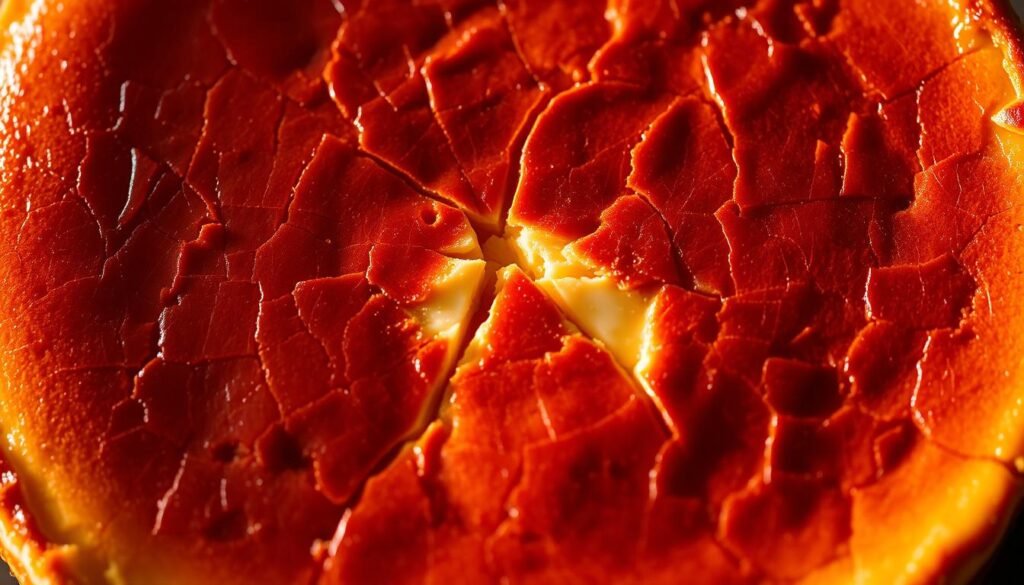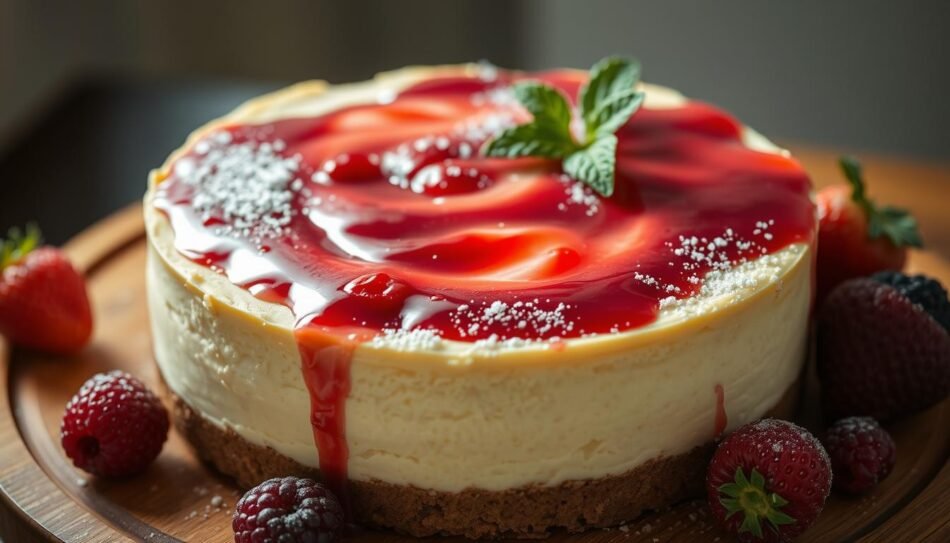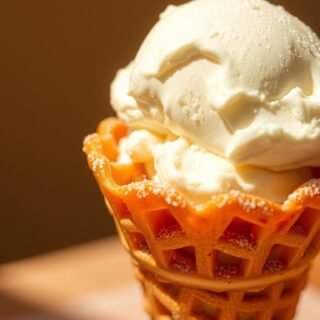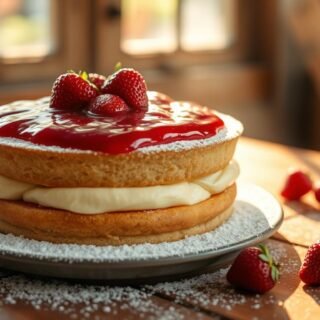Satisfy your sweet tooth with our decadent cheesecake recipes. Explore a collection of creamy, rich, and utterly divine cheesecakes.
Imagine slicing into a rich, creamy cheesecake with a perfectly baked graham cracker crust. The allure of this beloved dessert lies in its balance of sweetness and tanginess, making it a timeless favorite across generations.
To create this culinary masterpiece in your own kitchen, you’ll need to focus on the right ingredients and techniques. A great recipe is just the starting point. With the right guidance, you can master the art of making delicious homemade cheesecakes that will impress your family and friends.
By understanding the importance of quality cream and managing your time effectively, you’ll be well on your way to creating a truly exceptional dessert.
Key Takeaways
- Master the art of making a perfect graham cracker crust for your cheesecake.
- Learn how to balance sweetness and tanginess in your cheesecake filling.
- Understand the importance of using high-quality ingredients in your recipe.
- Discover techniques for achieving a smooth and creamy cheesecake texture.
- Find out how to manage your time effectively when baking a cheesecake.
The Art of Perfect Cheesecake
Achieving the perfect cheesecake is a culinary art that requires precision and patience. It’s about creating a dessert that’s both rich and light, with a smooth, creamy texture that melts in your mouth.
What Makes a Great Cheesecake
A great cheesecake strikes a delicate balance between sweetness and tanginess. The quality of your cream cheese fundamentally affects your cheesecake’s flavor and texture; always opt for full-fat, brick-style cream cheese for the best results. Ensuring that your ingredients are at room temperature is crucial for a smooth batter and even baking.
| Characteristics | Ideal Cheesecake | Common Issues |
|---|---|---|
| Texture | Smooth, creamy | Lumpy, cracked |
| Crust | Firm, not hard | Soggy, too crunchy |
| Baking | Evenly baked | Overcooked, undercooked |
Common Cheesecake Challenges
Common challenges include cracks on the surface, over-mixing the batter, and improper baking temperatures. To avoid these pitfalls, it’s essential to mix your batter just until the ingredients are combined and to bake your cheesecake at a consistent temperature. Proper cooling techniques are also vital to prevent cracking.
By understanding these challenges and taking steps to mitigate them, you can create a cheesecake that’s both visually appealing and delicious.
Essential Ingredients for Classic Cheesecake
When it comes to making a classic cheesecake, the quality of the ingredients is paramount. You need to select the right components to achieve that signature creamy texture and rich flavor.
Cream Cheese: The Foundation
Full-fat brick cream cheese is the cornerstone of a classic cheesecake. Never use the spreadable kind in tubs, as it lacks the density and fat content necessary for that signature creamy texture. Using the right cream cheese ensures your cheesecake has the perfect foundation.
Supporting Ingredients
Other essential ingredients include eggs for structure, sour cream for extra creaminess, and sugar for sweetness. The eggs act as a binding agent, helping the filling set properly while maintaining a smooth consistency. Meanwhile, sour cream adds a tanginess that balances the sweetness, contributing to the velvety texture of the filling. A touch of vanilla can also elevate the flavor profile.
Graham Cracker Crust Components
A traditional graham cracker crust requires graham cracker crumbs, melted butter, and a little sugar. The ratio of crumbs to butter to sugar is crucial for creating a firm yet tender base that complements the creamy filling. Ensuring the right balance will result in a perfectly baked graham cracker crust.
Equipment You’ll Need
To achieve a perfect cheesecake, it’s vital to have the appropriate baking tools. The right equipment ensures that your cheesecake turns out delicious and visually appealing.
Springform Pan Essentials
A 9-inch or 10-inch springform pan is essential for cheesecake baking. Its removable sides make it easy to release the cake without damaging it. To prepare the pan, grease it properly and wrap the bottom with heavy-duty aluminum foil to prevent water from seeping in during the water bath process.
Mixing and Baking Tools
An electric mixer (stand or hand) is crucial for incorporating ingredients thoroughly without introducing too much air. You’ll also need mixing bowls, preferably made of glass or stainless steel, as they conduct heat evenly and help bring cold ingredients to room temperature more quickly.
| Tool | Purpose |
|---|---|
| Springform Pan | Baking and releasing the cheesecake |
| Electric Mixer | Mixing ingredients thoroughly |
| Mixing Bowls | Holding and mixing ingredients |
| Heavy-duty Aluminum Foil | Preventing water leakage during water bath |
Classic New York Cheesecake Recipe
Experience the iconic New York cheesecake, celebrated for its rich, creamy texture and impressive stature. This classic dessert is a staple in delis and bakeries throughout the Big Apple, and with this recipe, you can recreate it in the comfort of your own home.
Graham Cracker Crust Preparation
The foundation of a great cheesecake is its crust. To prepare the graham cracker crust, combine 1½ cups graham cracker crumbs, 5 tablespoons melted butter, and 2 tablespoons sugar in a bowl. Mix until the crumbs are evenly moistened. Press the mixture into the bottom of a springform pan to form a compact layer. Pre-bake the crust at 375°F for 10 minutes to give it a lightly golden color and a crunchy texture.

Creamy Cheesecake Filling
The cheesecake filling is where the magic happens. Beat 32 oz cream cheese with 1 cup sugar until smooth, about one minute. Add 2/3 cup sour cream, vanilla, and a pinch of salt, mixing until well combined. Incorporate eggs one at a time on low speed to prevent air bubbles and ensure a smooth, crack-free surface. This meticulous process is crucial for achieving the signature New York cheesecake texture.
« A good cheesecake is like a good friend – it’s always there for you, and it’s always a pleasure to be around. » – Unknown
Baking Instructions
To bake the cheesecake, preheat your oven to 325°F. Pour the cheesecake filling into the prepared pan over the graham cracker crust. Bake for 50-60 minutes or until the edges are set and the center is just slightly jiggly. This balance is key to a perfectly baked cheesecake. Avoid overbaking, as it can cause the cheesecake to dry out or crack.
| Baking Time (minutes) | Oven Temperature (°F) | Cheesecake Status |
|---|---|---|
| 50-60 | 325 | Edges set, center jiggly |
By following these steps and using quality ingredients, you’ll be on your way to creating a classic New York cheesecake that’s sure to impress.
The Water Bath Technique
For a flawless cheesecake, understanding and implementing the water bath technique is essential. This method involves baking the cheesecake in a pan surrounded by water, which creates a humid environment that promotes even baking and reduces the likelihood of cracks.
Why Water Baths Matter
A water bath is crucial for achieving the perfect cheesecake texture. It provides gentle, even heat that prevents the custard from cooking too quickly, thereby reducing the risk of cracks. The steam generated by the water bath helps your cheesecake rise slowly and evenly, significantly improving its texture and appearance.
How to Properly Set Up a Water Bath
To set up a water bath, you’ll need to wrap your springform pan in heavy-duty aluminum foil to prevent leaks. Then, place the wrapped pan in a larger roasting pan and pour boiling water into the roasting pan to a depth of about 1 inch up the sides of the springform pan. This technique ensures that your cheesecake bakes in a humid environment, promoting a smooth and even finish.
| Water Bath Setup | Purpose |
|---|---|
| Wrapping springform pan in foil | Prevents water from leaking into the pan |
| Placing pan in a larger roasting pan | Creates a water bath environment |
| Adding boiling water | Generates steam for even baking |
By mastering the water bath technique, you can significantly improve the quality of your cheesecakes, achieving a smooth, crack-free surface and a perfectly cooked interior.
Must-Know Tips for Baking the Perfect Cheesecake
A perfectly baked cheesecake is within your reach when you know the secrets to avoiding common pitfalls. To ensure your cheesecake turns out creamy and delicious, follow these essential tips.
Room Temperature Ingredients
Having all ingredients at room temperature is crucial for a smooth cheesecake batter. Cold cream cheese, in particular, can remain lumpy no matter how long you beat it. Take the time to let your ingredients come to room temperature before mixing.
Proper Mixing Techniques
Mix your cheesecake batter on low speed just until the ingredients are incorporated. Over-mixing introduces air into the batter, which can cause cracks during baking. Be gentle and patient when mixing to achieve a crack-free cheesecake.
Cooling Methods to Prevent Cracks
Gradual cooling is key to preventing cracks in your cheesecake. Turn off the oven, crack the door, and let the cheesecake cool inside for an hour before moving it to room temperature. This slow cooling process helps prevent sudden temperature changes that can cause cracks.
Testing for Doneness
Test your cheesecake for doneness by gently shaking it. The edges should be set, while the center still jiggles slightly. This indicates that the cheesecake will continue to cook and set as it cools. Avoid overbaking, as this can cause dryness and cracking.
| Tip | Benefit |
|---|---|
| Room temperature ingredients | Smooth batter, reduced lumps |
| Proper mixing techniques | Crack-free cheesecake, reduced air bubbles |
| Gradual cooling | Prevents cracks, ensures even cooling |
| Testing for doneness | Avoids overbaking, ensures creamy texture |
Delicious Cheesecake Variations
Elevate your cheesecake game with these creative variations that will tantalize your taste buds. You can transform your classic cheesecake recipe into a masterpiece with innovative twists that suit every season and taste preference. The key to these variations lies in the ingredients and techniques you choose.
Fruit-Topped Cheesecakes
Fruit-topped cheesecakes are a delightful way to add color, flavor, and visual appeal to your dessert. You can feature fresh berries, homemade compotes, or elegant glazes on top of your cheesecake. The cream cheese filling provides a rich base that complements the sweetness of the fruit. For example, a strawberry glaze made with fresh strawberries and a touch of sugar can elevate your cheesecake to a new level.
Chocolate Variations
For chocolate lovers, incorporating melted chocolate into your cheesecake batter or creating a chocolate graham cracker crust can be a game-changer. The process of baking the cheesecake with chocolate ingredients enhances the flavor and texture. You can also top your cheesecake with decadent ganache or chocolate shavings for an extra layer of indulgence.
| Chocolate Variation | Description |
|---|---|
| Chocolate Crust | Made with chocolate graham crackers and melted butter |
| Chocolate Filling | Incorporates melted chocolate into the cheesecake batter |
| Chocolate Ganache | A rich, velvety topping made with chocolate and cream |
No-Bake Cheesecake Options
No-bake cheesecakes offer a refreshing alternative to traditional baked cheesecakes. These desserts use gelatin or condensed milk to set the filling without baking, requiring several hours in the refrigerator to firm up. The cream cheese and other ingredients are mixed together and then chilled, resulting in a light and creamy texture. This method saves time and can be just as delicious as its baked counterpart.
« No-bake cheesecakes are a great option for warm weather or when you want to avoid heating up your kitchen. »
By understanding the fundamental differences between baked and no-bake cheesecakes, you can choose the best method for your needs and preferences.
Troubleshooting Common Cheesecake Problems
Achieving a flawless cheesecake is a challenge many bakers face, but understanding common issues can help you overcome them. Even experienced bakers encounter problems, but most can be resolved with simple solutions once the causes are understood.
Preventing and Fixing Cracks
Cracks in cheesecakes are often caused by over-mixing the batter, baking at too high a temperature, or cooling too quickly. Using a water bath and cooling the cheesecake gradually in the oven helps prevent cracks. To fix cracks, you can strategically apply toppings like fruit compote, whipped cream, or chocolate ganache that hide imperfections while adding flavor.

Texture Issues and Solutions
Texture issues may result from over-baking, leading to a dry, grainy texture, or under-baking, resulting in a too soft center. A cheesecake is done when the edges are set but the center still has a slight wobble. To achieve the perfect texture, it’s crucial to recognize the signs of both under-baking and over-baking, and adjust your baking time and pan preparation accordingly.
By mastering these techniques and understanding the causes of common cheesecake problems, you can significantly improve your baking outcomes.
Storing and Serving Your Cheesecake
To enjoy your cheesecake at its best, follow these storage and serving tips. Proper storage is crucial for maintaining the texture and flavor of your cheesecake.
Refrigeration Guidelines
Your cheesecake should be refrigerated for at least 4 hours or overnight before serving. It can be stored in the refrigerator for up to 5 days. To prevent it from absorbing refrigerator odors, cover it properly. Remove the springform ring carefully, then cover the cheesecake with plastic wrap or aluminum foil.
Freezing Instructions
To freeze, wrap the completely cooled cheesecake in plastic wrap, then aluminum foil. It can be frozen for up to 3 months. When you’re ready to serve, thaw the cheesecake overnight in the refrigerator.
| Storage Method | Duration | Tips |
|---|---|---|
| Refrigeration | Up to 5 days | Cover with plastic wrap or aluminum foil |
| Freezing | Up to 3 months | Wrap in plastic wrap and aluminum foil, thaw overnight |
By following these guidelines, you’ll be able to enjoy your cheesecake for a longer period while maintaining its quality.
Conclusion
As you’ve learned, making a great cheesecake involves several key steps and techniques. To achieve success, remember to use quality ingredients at room temperature, avoid over-mixing, and bake in a water bath. With these techniques, you’ll be able to create delicious homemade cheesecakes that rival those from professional bakeries.
Patience is crucial, from allowing ingredients to come to room temperature to the lengthy cooling and chilling process, which can take several hours. By mastering the art of homemade cheesecake, you can create a dessert that’s not only impressive but also customizable to your preferences.
With practice, you’ll improve your skills and understanding of this classic dessert’s nuances, making the time and effort worthwhile. Few desserts receive the same appreciation as a carefully crafted cheesecake on top.









